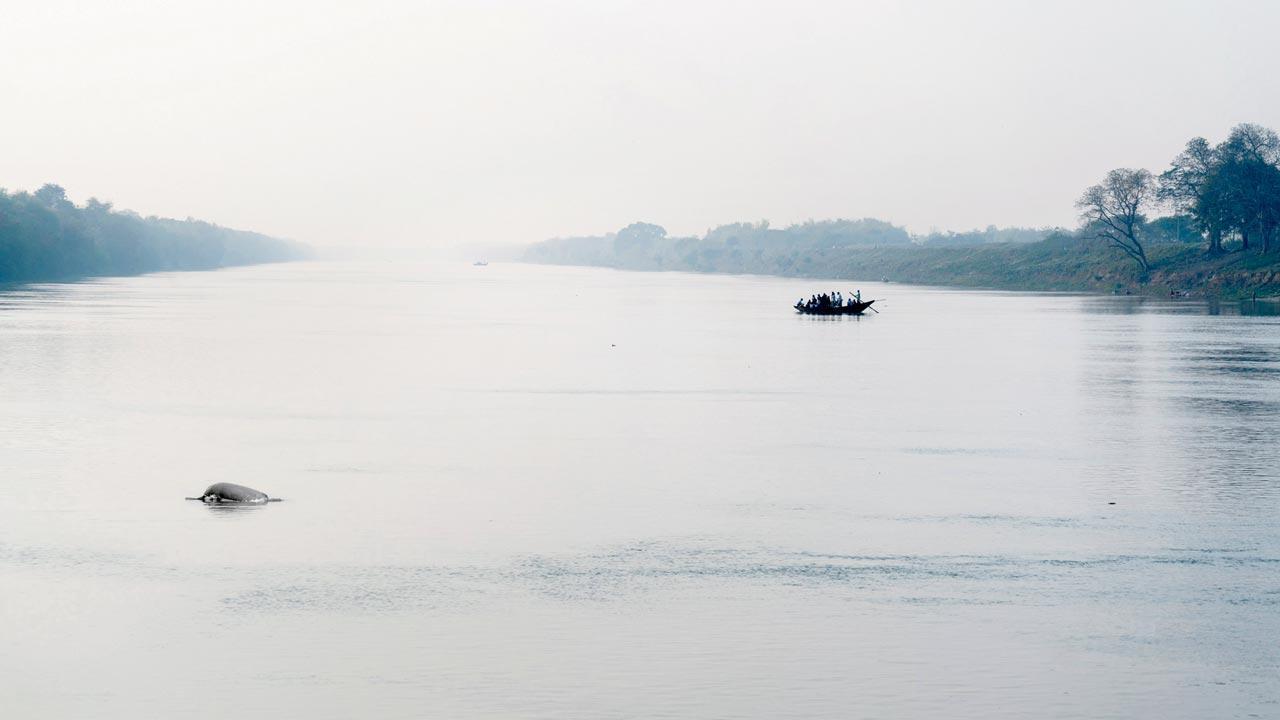It is probably the most intelligent, compassionate, playful and wise creature on earth. Why would they bludgeon a river dolphin to death?

A Ganges River Dolphin seen crossing the river. Pic/Getty Images

On the last day of last year they found a dead fish a little over five feet long on the embankment of Sharda Sahayak Canal in Pratapgarh district, Uttar Pradesh.
ADVERTISEMENT
A marine biologist would have recognised it easily from its long snout, tiny eyes and typical bulging forehead as a Ganges River Dolphin. How it had been beaten and slashed to death became clear the next day when, as you’d expect, an explicit video went viral on social media. It showed a group of villagers gleefully bludgeoning and butchering the creature, growing excited as the water grew pink and then red. A voice is heard repeatedly pleading, “Phaltu maarta hai,” (You’re killing it for no reason) but there was too much bloodlust in the air.
Someone had sighted the river dolphin, designated India’s Aquatic Animal, earlier. Perhaps they would have recognised it more readily back when they numbered in the tens of thousands, in the days before the government’s Jal Marg Vikas project began terraforming the Ganga river to accommodate 1,500-2,000 tonne vessels. Now no more than 3,500 exist, and the number is dwindling.
As human beings do when they encounter anything unfamiliar, the villagers’ first thought was to kill it. Someone pronounced it a deadly threat; no one disputed it. In the ensuing bloodbath, a mob of ignorant men vented their brutality with ferocity and glee on a blind fish, using an axe and sticks. The dolphin didn’t stand a chance.
But it was only one dolphin, you might protest. Look at the Japanese — every year, with their government’s blessings, they herd up to 2,000 dolphins into a cove and spend the rest of the day battering and hacking them to death for their meat, turning the cove’s water crimson with the blood of butchery.
Well, you obviously don’t know dolphins at all.
I am not an animal rights activist but there is something about the dolphin that humbles me. My love for them is visceral; perhaps it is their kind face, twinkling eyes or exuberant innocence. In fable, they saved sailors stranded at sea. In countless videos, they play with thrilled children and take them for rides, capricious yet supremely gentle. Their tweets, trills and chirps have been analysed for over 50 years for signs of a language.
The dolphin may be one of the most evolved forms of life on earth. Its brain, at 1,600 grams, is 25% heavier than ours. A better sign of intelligence, however, is its EQ, or encephalisation quotient, a ratio which captures how much bigger a brain is than that animal requires to go about its life, or the expected brain size versus the actual. Human EQ is 7.4-7.8. Next comes the dolphin, with 5.3. The ‘smart’ chimpanzee is a low third, at 2.2.
Here’s what we already know — dolphins are impressive problem-solvers. Some have been observed using a lobster as bait to catch larger fish but covering their snout with sea sponges to avoid being stung.
They are irrepressibly curious and learn rapidly. Not only have they mastered human hand signs but they have independently constructed sentences they were not taught using those signs, and used their snouts on a keyboard to communicate their thoughts.
Like humans, dolphins seem to have names. Each dolphin is thought to invent a unique ‘signature whistle’ for itself when it is a calf. For the rest of its life, it is greeted with this call sign. Dolphins have been shown to remember the signature whistles of other dolphins for decades.
In one remarkable experiment, Stan Kuczaj, a 70-year-old scientist who has published more papers on dolphins than anyone else, worked with two dolphins already trained to perform tricks for children. That day, he gave them a sign meaning Innovate. He wanted them to perform something they hadn’t been taught.
The dolphins dove down to the pool’s bottom, where video cameras and hydrophones captured them chirping and trilling at each other, ostensibly discussing a plan of action. Then they surfaced, rolling over together in unison, flapping their tails exactly three times in perfect sync.
Here’s why dolphins humble me. Their brains’ centre for processing emotions is extremely well developed. Dolphins apparently feel emotions as we do — grief, joy, anger, caprice, sadness. They form social groups like us and understand friendships and loyalty. But unlike us, they do not display greed, vengefulness, avarice, selfishness or malice.
Of all the creatures on this wretched planet, the dolphin that villagers of Pratapgarh beat to its death was capable of the greatest kindness, trust, gentleness and compassion towards its own kind — and towards humans.
In May 2013, the Ministry of Environment and Forests declared dolphins to be ‘non-human persons’. In a world where being human more often means being violent, pointlessly cruel and savage, non-human seems like a perfect description of a dolphin.
Here, viewed from there. C Y Gopinath, in Bangkok, throws unique light and shadows on Mumbai, the city that raised him. You can reach him at cygopi@gmail.com
Send your feedback to mailbag@mid-day.com
The views expressed in this column are the individual’s and don’t represent those of the paper
 Subscribe today by clicking the link and stay updated with the latest news!" Click here!
Subscribe today by clicking the link and stay updated with the latest news!" Click here!







